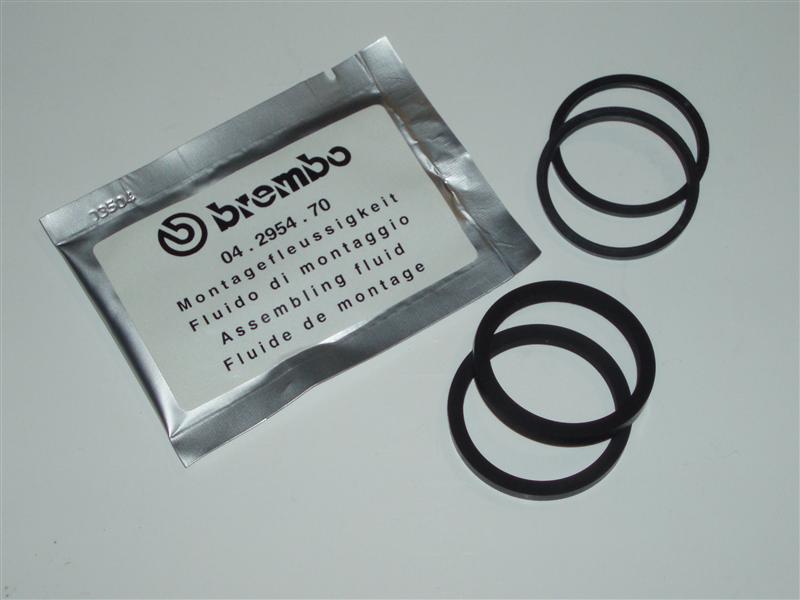Page 1 of 1
Brake caliper pressure seal.
Posted: Wed Jan 15, 2020 5:45 am
by chrismckay
Question on the orientation of the pressure seal in a rear brake caliper.
When replacing the pressure seal is it possible to insert them upside down?.
I have been searching google for ages and get conflicting advise.One youtube video says that there is a bevel on the seal not visible to the human eye and that you should feel a lip on the seal once inserted dragging your finger from the inside of the caliper over the seal to the outside of the caliper.
Another website suggests that the recess for the seal is angled so as to cause a lip on the hydraulic side of the seal.
Anybody know???
Chris...
Re: Brake caliper pressure seal.
Posted: Wed Jan 15, 2020 6:03 am
by STeinar
"[size=2px]the seal is angled so as to cause a lip on the hydraulic side of the seal" is the right one [/size]
[size=2px]
[/size]
Re: Brake caliper pressure seal.
Posted: Wed Jan 15, 2020 7:35 am
by chrismckay
STeinar wrote:
"the seal is angled so as to cause a lip on the hydraulic side of the seal" is the right one [/size]
[/size]
Steiner, thanks for the reply.
Is the angle caused by an angle in the caliper seal recess, promoting an angle on the seal hydraulic side or is the seal itself angled?
I have seen a video on youtube claiming that there is an angle on the seal too small for the human eye to see and I have also seen a drawing of a generic caliper showing the caliper seal recess at an angle!!!
edit....just re-read your reply and you have answered!!!
Re: Brake caliper pressure seal.
Posted: Wed Jan 15, 2020 7:42 am
by STeinar
chrismckay wrote:
Is the angle caused by an angle in the caliper seal recess, promoting an angle on the seal hydraulic side or is the seal itself angled?
I have seen both ways - but not sure what BMW is using .
The trick is to have something that is blocking for the oil pressure from the inside - but - lets the piston retract easily (going back when no oil pressure inside)
In some cases - the rubber seal is made so it will help the piston retract - when the rubber seal tries to retain its normal form and shape .
Re: Brake caliper pressure seal.
Posted: Wed Jan 15, 2020 8:44 am
by David.
This is the rear caliper seal kit for a 2012 TC RT.

With the help of a knowledgeable friend, had the seals replaced on a 2012 RT, don't recall them being directional.
The pistons need to be able to move in both directions, out & in without leaking brake fluid.
When cleaning the caliper & exercising the pistons out & in, haven't noticed any fluid leaks.
Re: Brake caliper pressure seal.
Posted: Wed Jan 15, 2020 9:17 am
by David.
This video shows a Brembo/BMW front caliper being overhauled,
https://www.youtube.com/watch?v=JdWBz6hQlXc
At 3:00, it mentions the first (outer) narrower seal having a "double ridge". If this is the same design as the rear, perhaps it confirms that the seals cannot be inserted incorrectly & are therefore not directional.
My understanding is that the inner seal, (without a ridge), is the brake fluid seal and the outer seal is just a dust/dirt seal.
Bike Torque Racing are UK Importers and Distributors for Brembo, might be worth giving them a call to confirm,
https://www.biketorqueracing.co.uk/
Re: Brake caliper pressure seal.
Posted: Wed Jan 15, 2020 11:17 am
by chrismckay
As ever David, brilliant reply ;D
Re: Brake caliper pressure seal.
Posted: Wed Jan 15, 2020 11:45 am
by David.
Although not a Brembo/BMW caliper, at 4:10 in this video, it clearly shows the difference between the "thicker" bottom seal & the top seal with the double ridges.
https://www.youtube.com/watch?v=HYy-vPLmL0E
A nice explanation of what the seals do and how they work.
"There are two seals on each piston: an inner fluid seal, and an outer dust seal. The outer is to try and keep dirt out, and the inner one has two jobs: it holds the fluid inside, obviously, but it also keeps the piston in the right place. When you pull the brake lever, the fluid pushes the piston out and clamps the pads onto the disc. When you release it though, you need the piston to come back a little bit so the brakes let off. The rubber seal does this job: it distorts a little bit under pressure as the piston moves out, then pulls it back again a small amount when the pressure is released. As the pads wear, the seals let the pistons gradually move out further and further, taking up the extra clearance."
STeinar wrote:In some cases - the rubber seal is made so it will help the piston retract - when the rubber seal tries to retain its normal form and shape.
